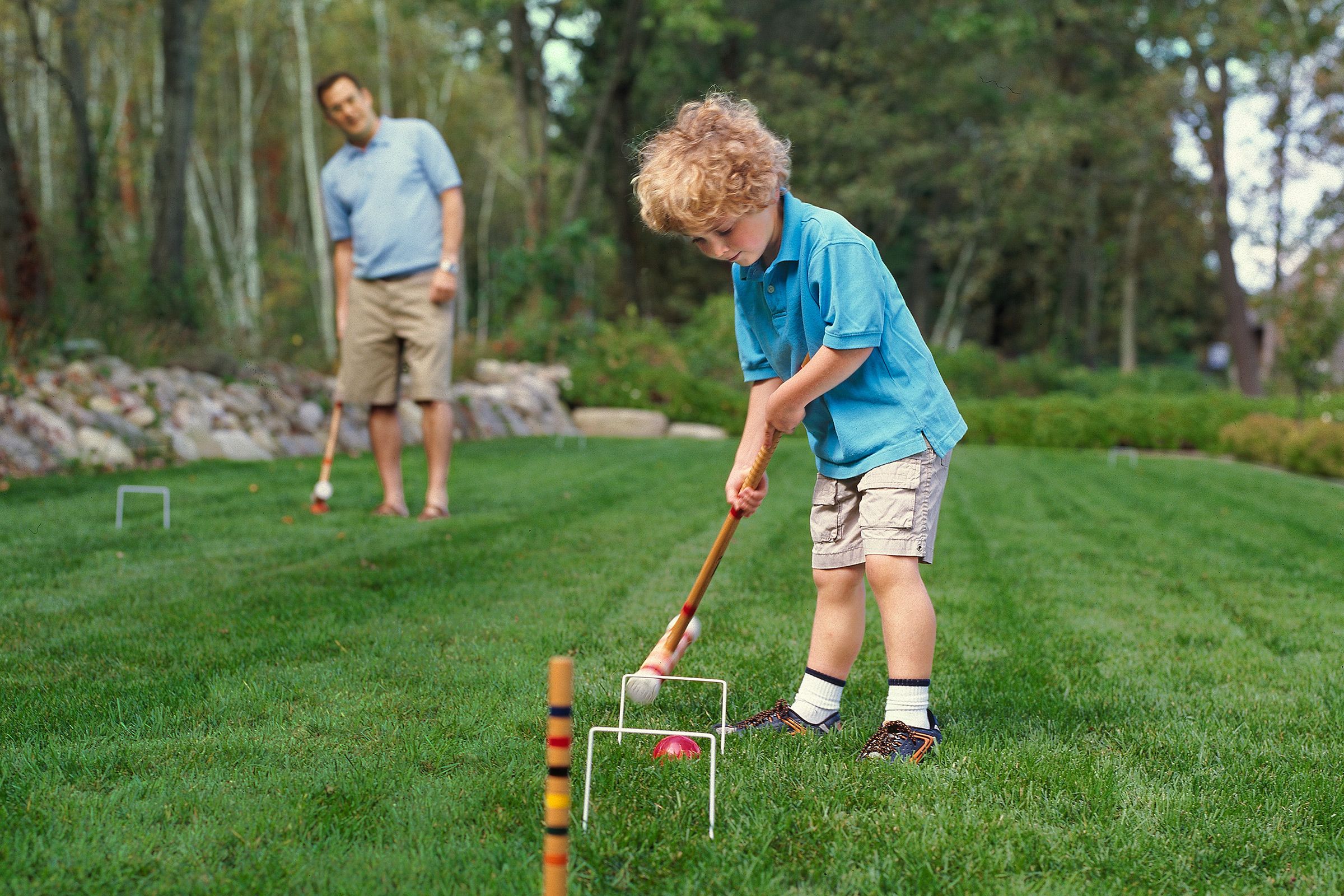Give guests a buffet of playtime options and they will make your home the season’s hottest destination. They’ll arrive early, stay late, bring treats, and call you the greatest host since Jay Gatsby. All it takes is a backyard filled with games suited to all ages and abilities, a place where family and friends can gather to face off—whether it be for an innocent competition or a heated grudge match. In other words: If you build it, they will come.
But to effect this kind of leisure-time loyalty, you need some sophisticated games. We’re not talking about staid badminton or weak-willed Wiffle ball. You need games of skill and strategy, games once played by warriors and kings—games like bocce, horseshoes, and croquet.
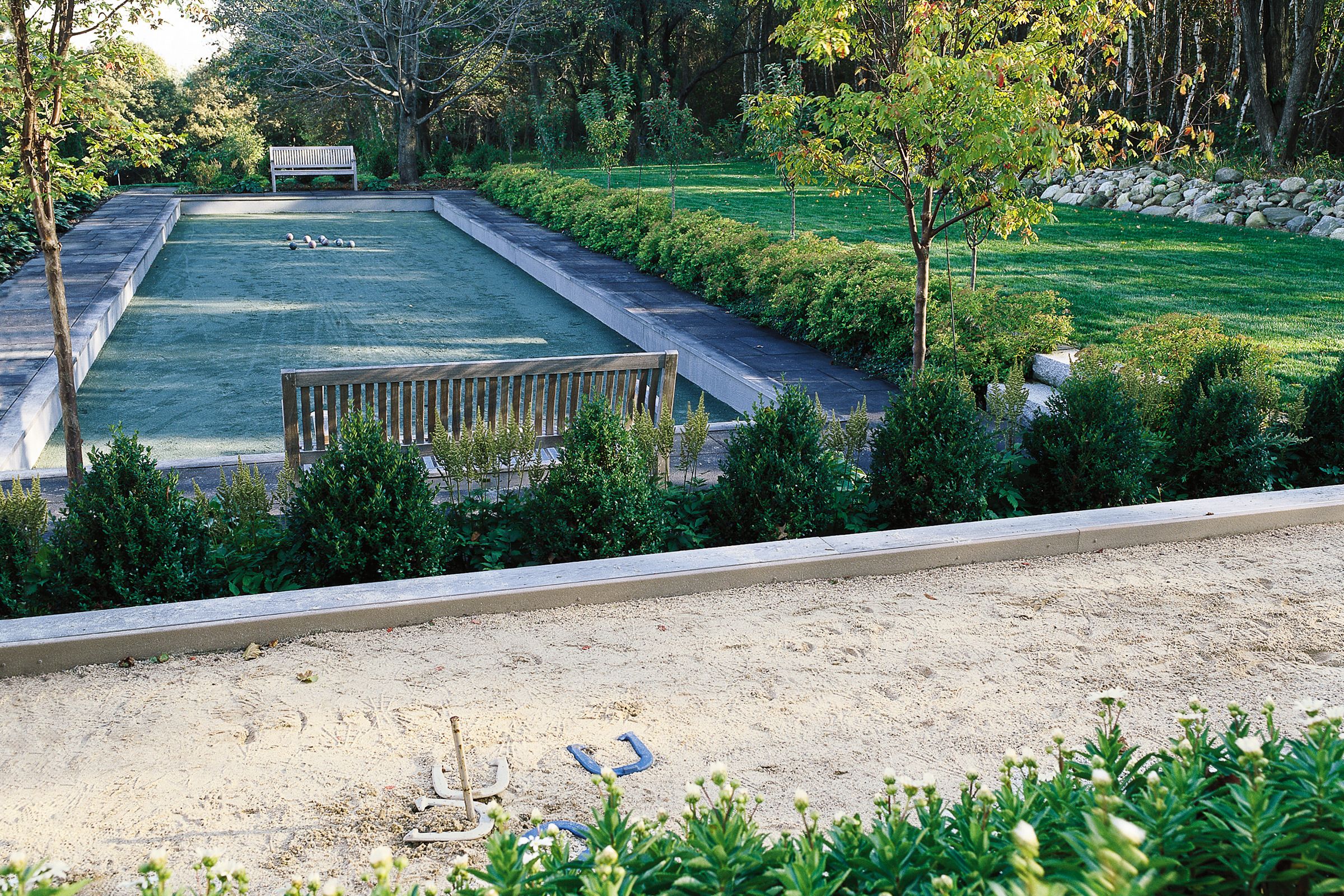
Working from a design by landscape architect Elliott Brundage, This Old House landscape contractor Roger Cook took one backyard, overgrown with bittersweet and poison ivy, and turned it into a sports lovers’ heaven, squeezing in a croquet lawn, a horseshoe pit, and a bocce court.
The low-maintenance play zones are close to the house and pool, where they offer options for entertainment after a morning swim or before a barbeque feast. Together, they provide the perfect enticement for fun-seekers. As Roger puts it, “Anything that gets people outside is a reason for the whole family to spend time together.”
Backyard Horseshoes Pit
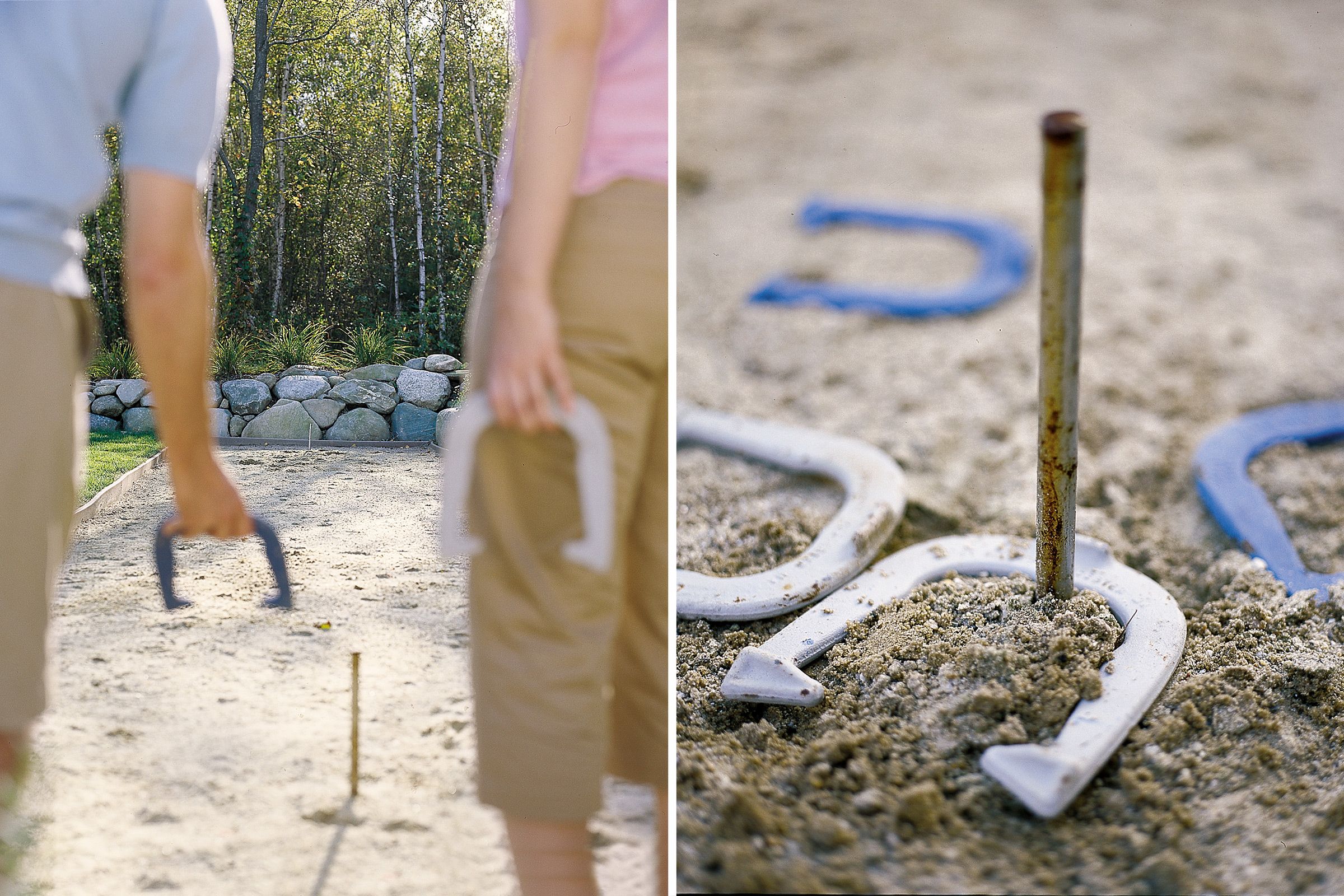
The satisfying clang of horseshoes wrapping around their target floats through the air on long summer afternoons, enticing adults and children alike to pick up the game. “Guests gravitate toward horseshoes because most people are familiar enough with the rules to play,” Brundage says. The 6-inch-deep sand also draws them in, evoking a backyard beach.
Sand is an ideal playing surface for the game; the 2-pound horseshoes are too punishing on grass or asphalt. And that’s really all this pit is a long rectangle filled with sand, surrounded by a durable frame. The official length for a horseshoe pit is 46 feet, but its design is basic enough to replicate on any long, flat sliver of land, as long as you leave 5 feet open behind each stake for safety. The maintenance is as simple as regular raking and the occasional fishing out of an errant leaf from nearby trees.
Steps for building the horseshoe pit
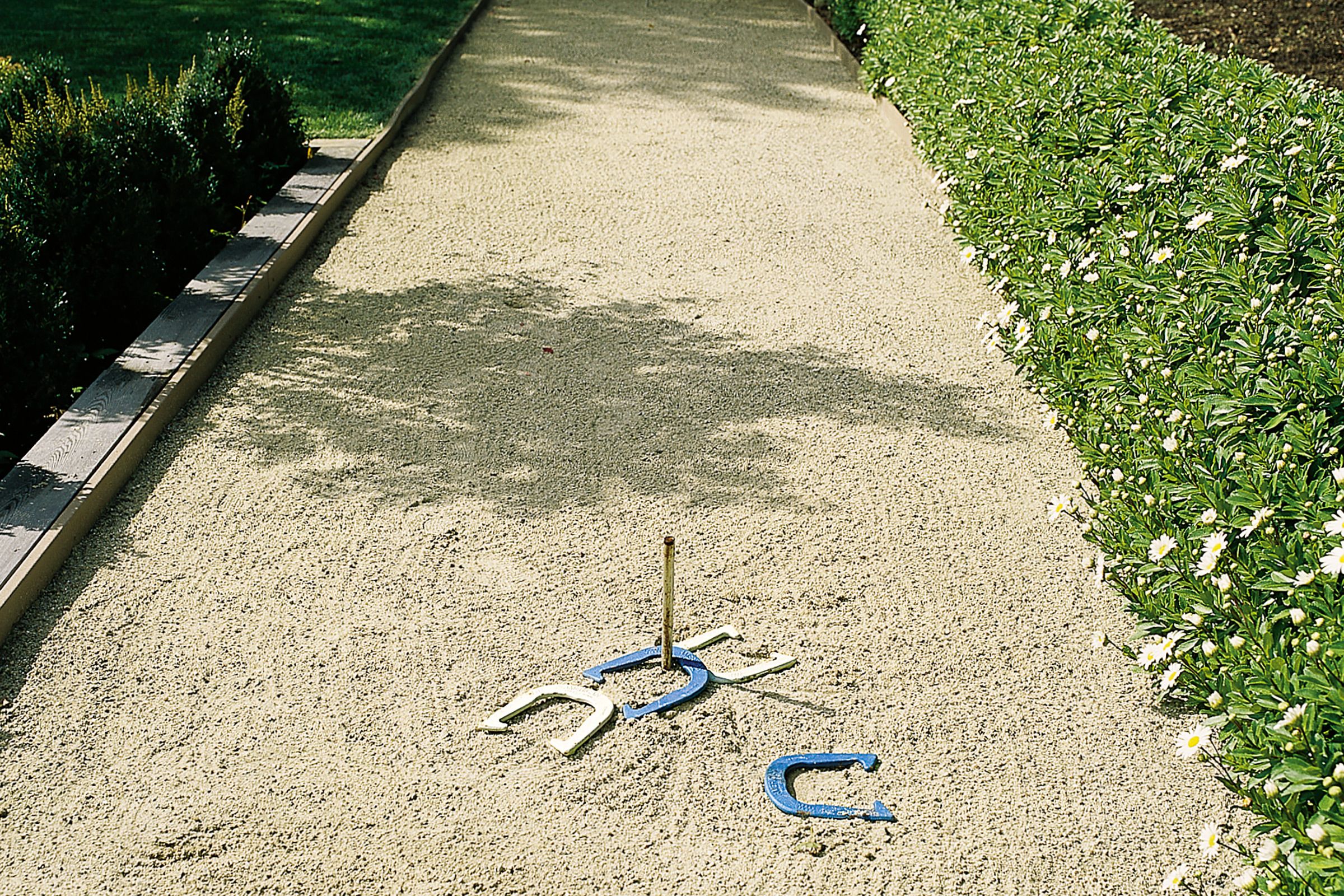
- Roger prepared the base of the pit by excavating the 8-by-42-foot area 6 inches down until he reached the subsoil. Then he put down a 6-inch layer of gravel and covered that with landscape fabric.
- To create the frame of the pit, he dug a 6-inch-deep trench around the perimeter of the gravel, then set 1×12 composite decking boards, turned on edge, into the trench. “The key is to keep the frame as simple as possible,” Roger says.
- He supported the boards with 2-foot-long 2×4 pressure-treated stakes pounded into the ground along the outside of the frame until they sat 3 inches below the top edge.
- He screwed the boards to the stakes to hold them up. The boards rise 1.5 inches above the adjacent croquet lawn to prevent croquet balls from rolling into the pit.

- Roger filled the frame with 6 tons of coarse sand, creating a 6-inch-thick layer that he raked level.
- Using a sledgehammer, he drove 3-foot metal stakes into either end of the pit, leaving 36 feet between them. The stakes protrude a regulation height of 15 inches above the playing surface.
Backyard Croquet
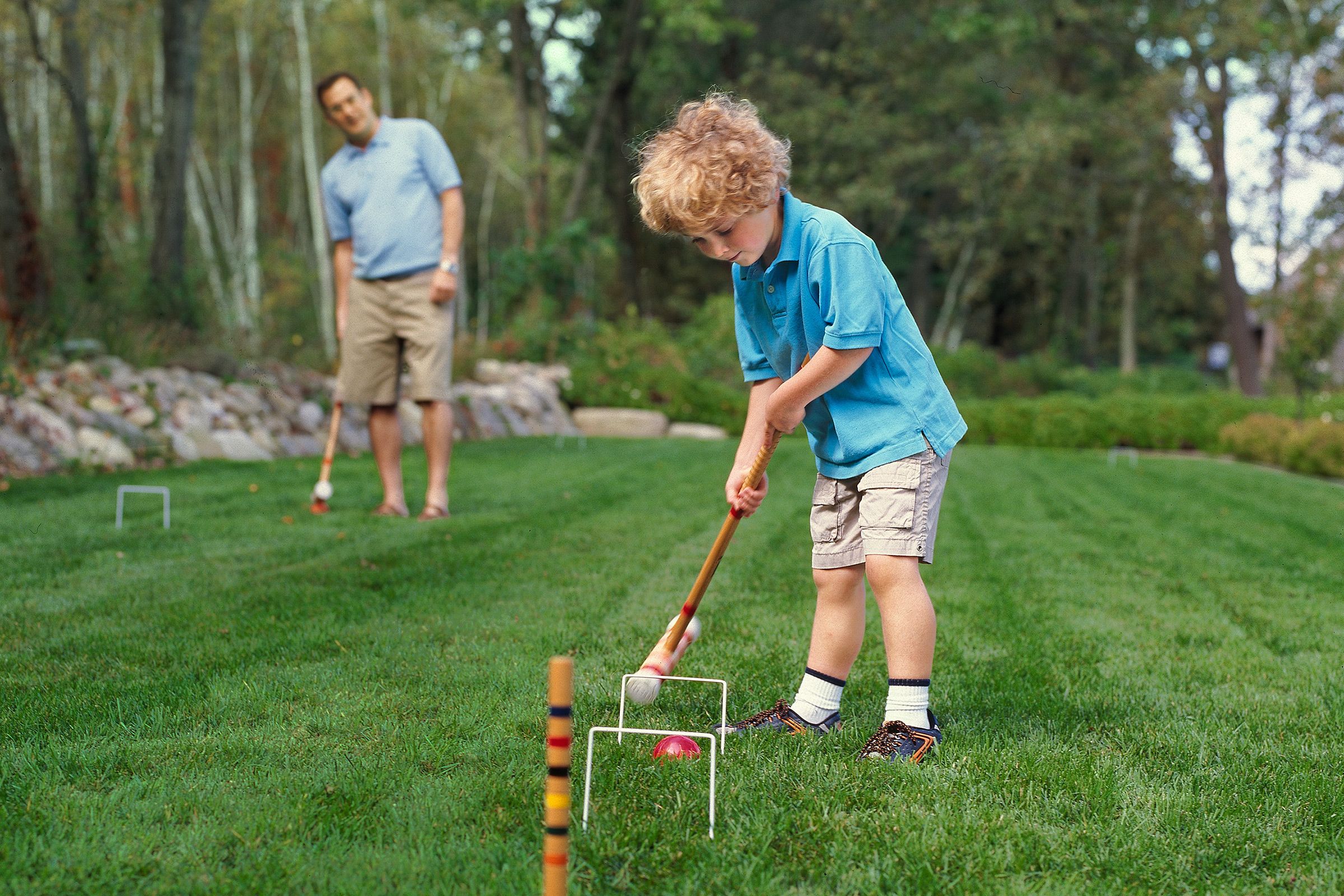
A lush lawn is a jewel in any backyard, but one with thick turf and a birch-tree forest border practically begs barefoot guests to come out and play. On this particular 23.5-by-84-foot patch, the game of choice is croquet; the lawn can accommodate a full game of six players. And while it’s nowhere near as big as the 5,000 square feet used in official games, the tough mix of bluegrass, rye, and fescue grasses will still stand up to the most zealous competitors.
For Roger, building the lawn was no different from any other sod project, though he added the step of making the field somewhat level. He amended the soil and laid the turf, then gave it a few weeks to take root before allowing players on the field. He also collected large stones that dotted the property to construct a rock wall boundary along one side, separating the gaming area from the trees. All that’s left is to place the wickets, grab a traditional wood mallet, and stroll the grounds for a leisurely game.
Steps for building the croquet lawn
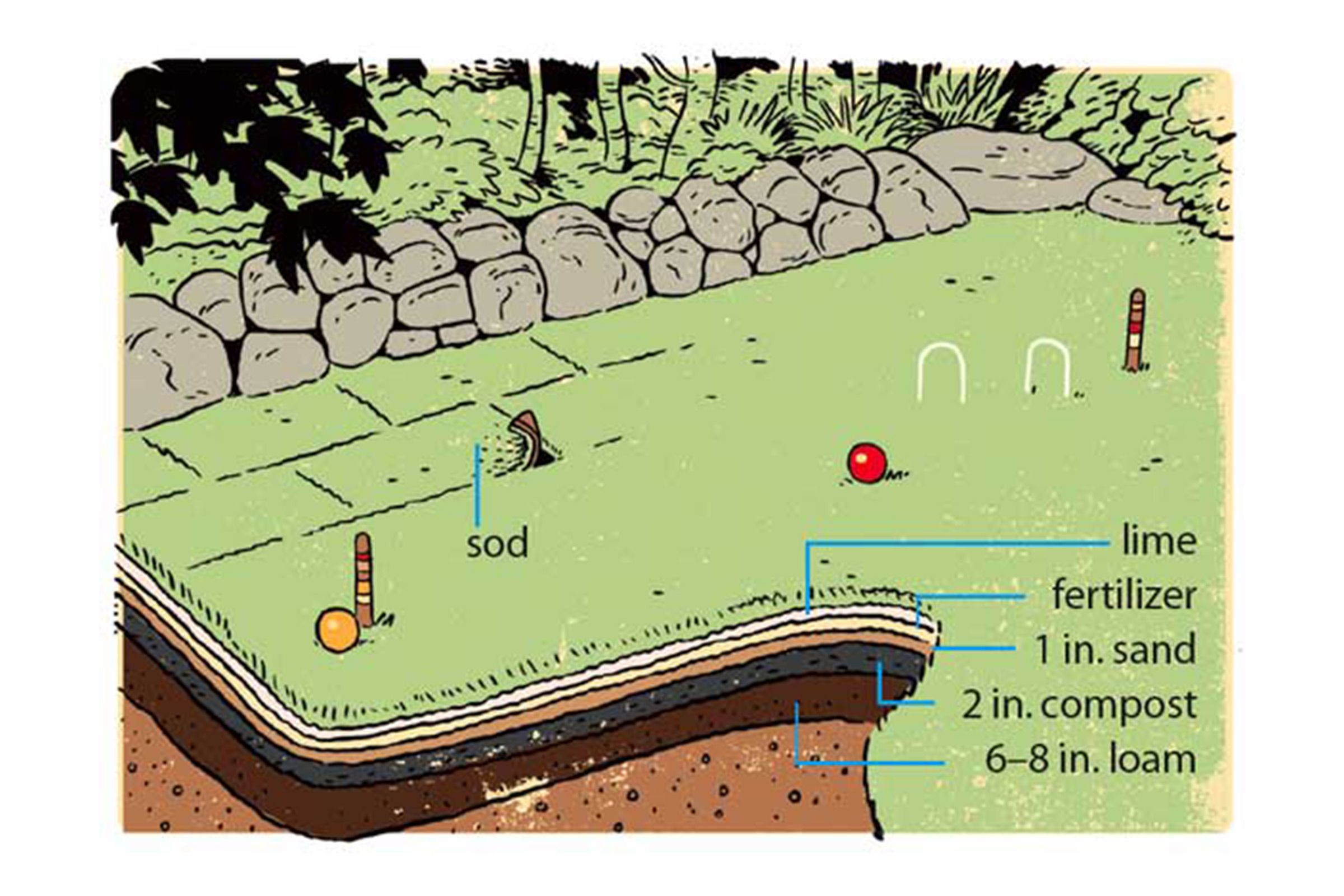
- After Roger cleared the area of brush, he enriched the soil by adding 6 to 8 inches of loam, 2 inches of compost, and an inch of sand (for drainage), then tilling the three layers together.
- To bring the soil to a pH suitable for turf grass (between 6 and 7.5), he spread starter fertilizer and lime, then raked the amendments into the top inch of soil. Once all was well mixed, his crew leveled out the surface with rakes.
- Roger chose to sod the location rather than seed to establish a quick, lush lawn. To avoid creating a clear grid, he laid the sod in a running bond pattern, making sure the seams between pieces didn’t line up with the seams from the next row.
- Once the sod was down, he watered it every morning for the first week to saturate the soil and encourage deep root growth.
- After three weeks and two mowings, the lawn was ready for play; in the following weeks, he cut back on watering, eventually tapering off to an inch a week.
Backyard Bocce
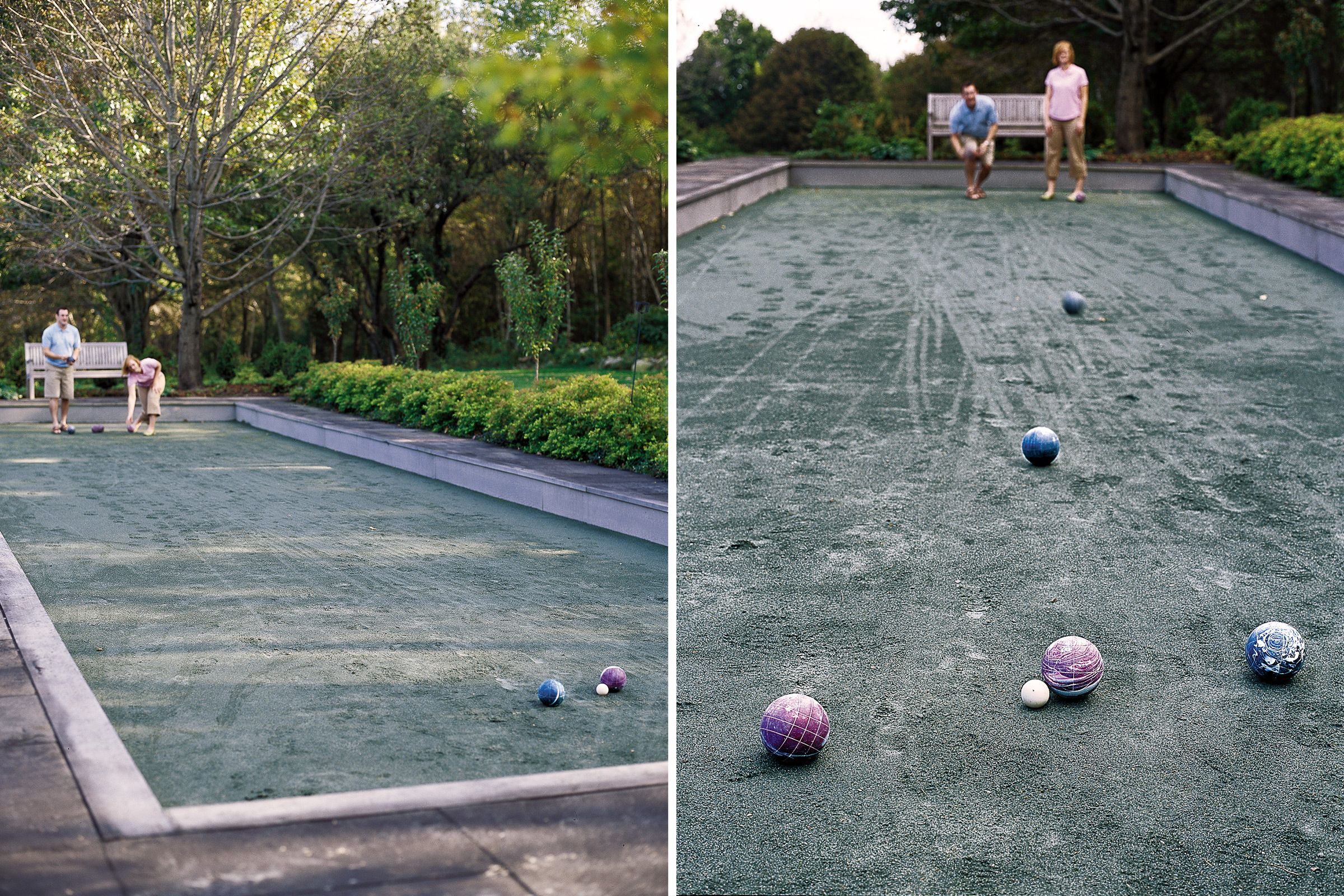
Bocce is a slow-tempo game, best enjoyed with the sun low and a cocktail in hand. The rules are simple enough: A small ball, called the pallino, gets tossed down the court and players must try to get as close as possible with their own balls, sometimes strategically knocking opponents out of the way.
A regulation bocce court is long—87.5 feet—and topped with the same clay used on traditional tennis courts. The court Roger built is only two-thirds regulation size, but that’s not an issue, as it is used by little players as well as big. Brundage’s design was inspired by courts in Boston’s North End, where Italian-Americans play into the evening under the park lights.
A deep frame of timbers contains packed gravel that supports the heavy clay of the bocce court and keeps it level. Composite decking on the inside face of the court resists dents, which a 2-pound bocce ball traveling at 10 mph will surely inflict on wood.
A bluestone walk surrounds the court and extends into a patio at one end with a teak bench for players and spectators under the maple trees. Along the side adjacent to the croquet lawn, ‘Gold Mound’ spiraea, six crabapple trees, and an 18-inch retaining wall create a clear demarcation.
Step for building the bocce court
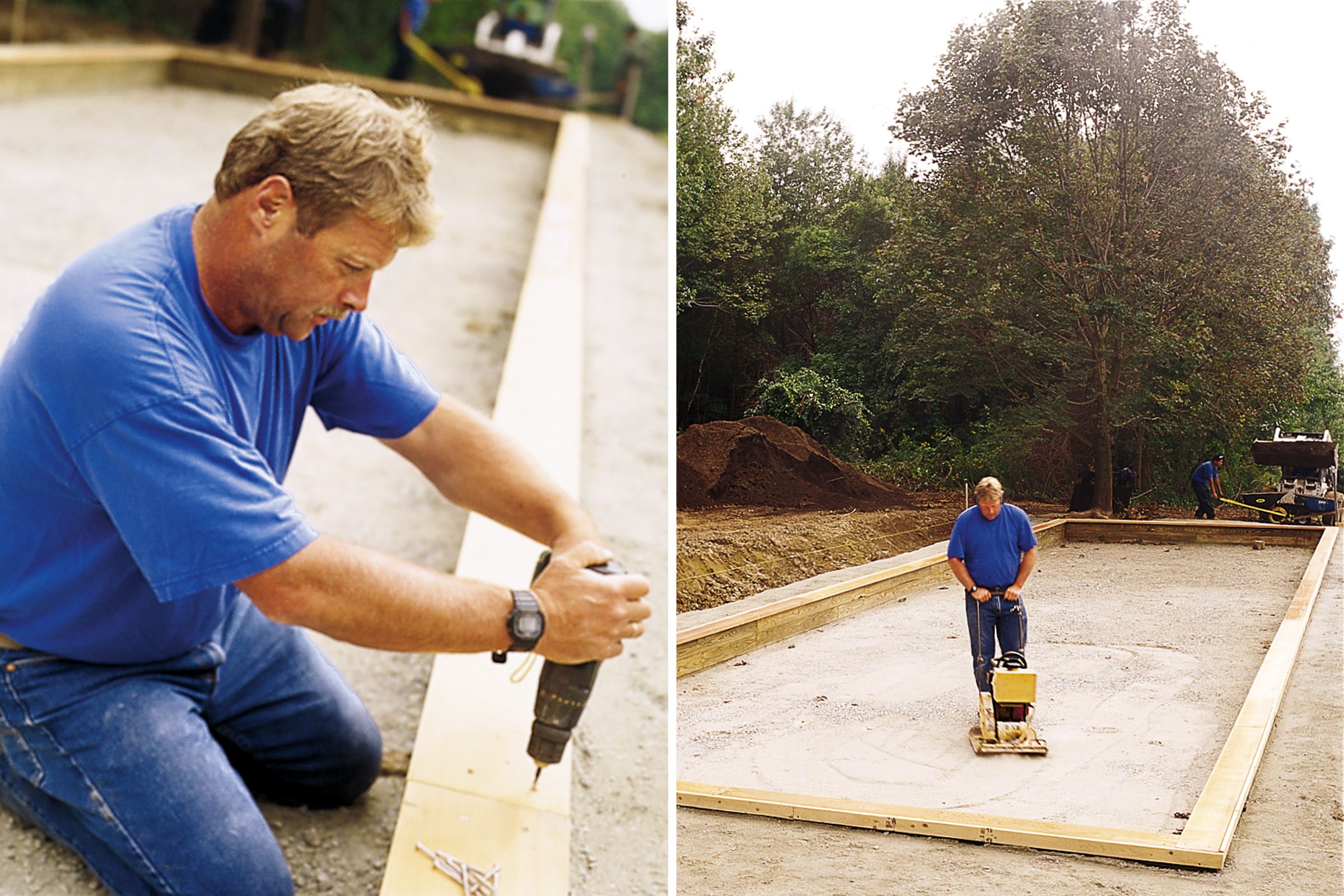
- Roger excavated the 16.5-by-61-foot area for the bocce court 26 inches below grade, then dug 6-inch trenches around the perimeter and filled them with 2 inches of gravel.
- He set the first course of 8-foot-long 6×6 timbers in the trenches on top of the gravel, butting the wood end-to-end along the walls and end-to-side at the corners. Once the timbers were set, he drilled through them every 2 feet and drove 18-inch rebar through the timbers and a foot into the ground.
- For the next four courses of timbers, Roger staggered the joints along the walls by 4 feet so they didn’t line up with the course below. He also alternated the timbers at the corners to make lapped joints. He drove timber screws through each new course and into the one below—two at each corner and every 18 inches along the sides—to tie them together. He capped the timbers with 2×12 cedar rails.
- To prep for the court surface, Roger laid a 6-inch-thick base of compacted gravel inside the timber walls. Then he wrapped a 4-inch perforated flexible pipe in filter fabric and laid it along the inside edge of the entire court.
- He capped one end and routed the other end through a hole in a timber he’d cut before he built the wall, so the pipe can drain rainwater away from the court surface. Once the pipe was set, he put down another 6-inch layer of compacted pack, a mix of gravel and stone dust.
- He lined the exposed inner face of the walls with 1×12 composite decking screwed to the timbers.
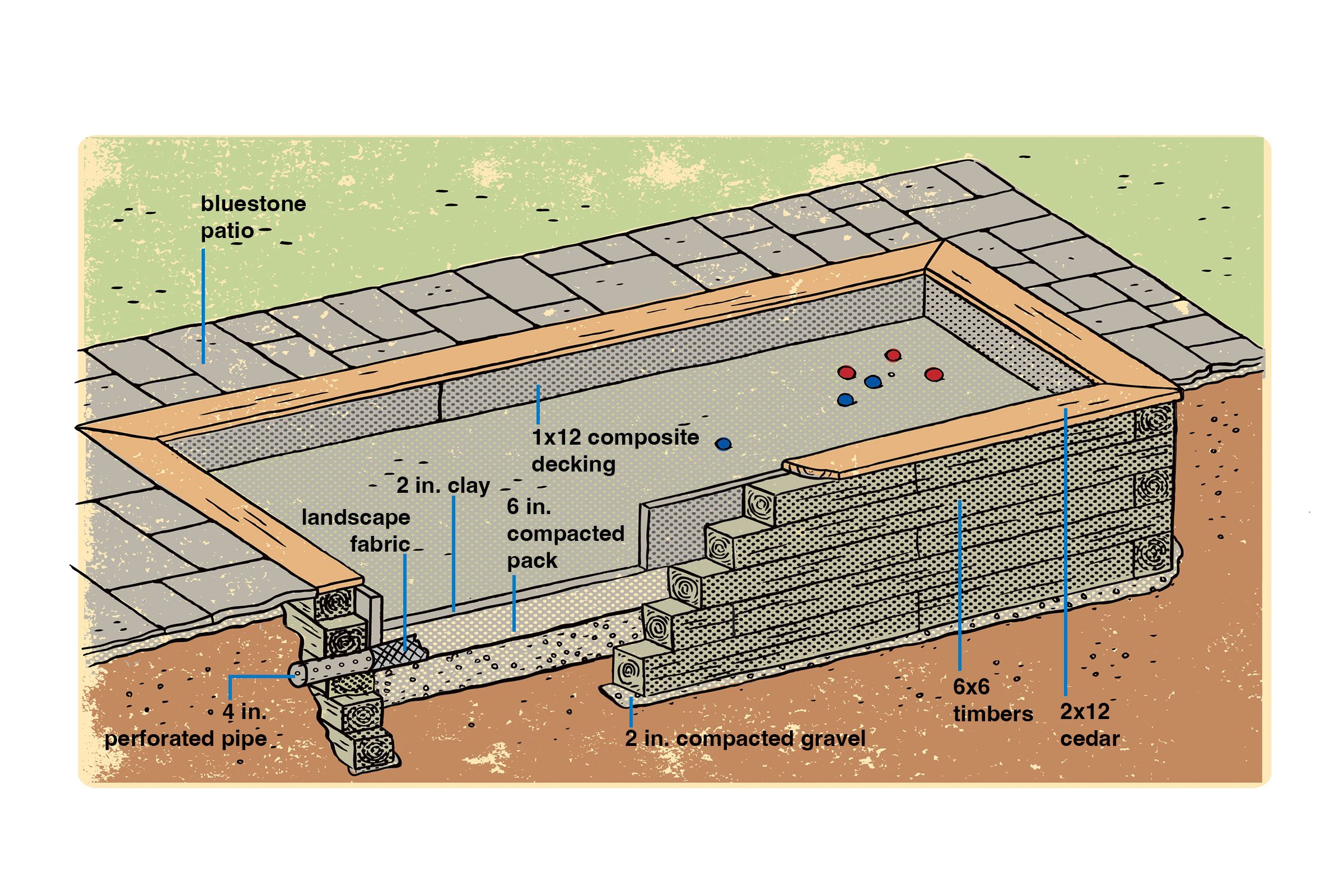
- To lay the clay surface, Roger set down metal poles that span the width of the court every 6 to 8 feet. Then he filled between the poles with 2 inches of clay, screeding off the excess by pulling a straightedge across two poles at a time.
- Once the entire surface was laid, screeded, and level, Roger took up the poles and filled in the voids. Using a water roller, he gently compacted the clay, working across the width of the court, then down the length twice to leave a smooth, even surface.
